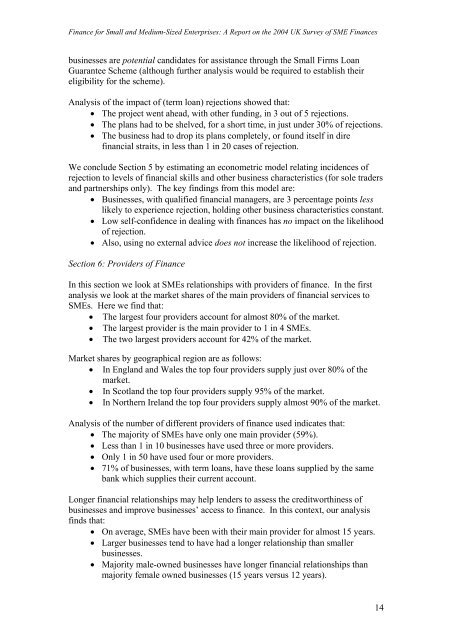Finance for Small and Medium-Sized Enterprises - DTI Home Page
Finance for Small and Medium-Sized Enterprises - DTI Home Page
Finance for Small and Medium-Sized Enterprises - DTI Home Page
You also want an ePaper? Increase the reach of your titles
YUMPU automatically turns print PDFs into web optimized ePapers that Google loves.
<strong>Finance</strong> <strong>for</strong> <strong>Small</strong> <strong>and</strong> <strong>Medium</strong>-<strong>Sized</strong> <strong>Enterprises</strong>: A Report on the 2004 UK Survey of SME <strong>Finance</strong>s<br />
businesses are potential c<strong>and</strong>idates <strong>for</strong> assistance through the <strong>Small</strong> Firms Loan<br />
Guarantee Scheme (although further analysis would be required to establish their<br />
eligibility <strong>for</strong> the scheme).<br />
Analysis of the impact of (term loan) rejections showed that:<br />
• The project went ahead, with other funding, in 3 out of 5 rejections.<br />
• The plans had to be shelved, <strong>for</strong> a short time, in just under 30% of rejections.<br />
• The business had to drop its plans completely, or found itself in dire<br />
financial straits, in less than 1 in 20 cases of rejection.<br />
We conclude Section 5 by estimating an econometric model relating incidences of<br />
rejection to levels of financial skills <strong>and</strong> other business characteristics (<strong>for</strong> sole traders<br />
<strong>and</strong> partnerships only). The key findings from this model are:<br />
• Businesses, with qualified financial managers, are 3 percentage points less<br />
likely to experience rejection, holding other business characteristics constant.<br />
• Low self-confidence in dealing with finances has no impact on the likelihood<br />
of rejection.<br />
• Also, using no external advice does not increase the likelihood of rejection.<br />
Section 6: Providers of <strong>Finance</strong><br />
In this section we look at SMEs relationships with providers of finance. In the first<br />
analysis we look at the market shares of the main providers of financial services to<br />
SMEs. Here we find that:<br />
• The largest four providers account <strong>for</strong> almost 80% of the market.<br />
• The largest provider is the main provider to 1 in 4 SMEs.<br />
• The two largest providers account <strong>for</strong> 42% of the market.<br />
Market shares by geographical region are as follows:<br />
• In Engl<strong>and</strong> <strong>and</strong> Wales the top four providers supply just over 80% of the<br />
market.<br />
• In Scotl<strong>and</strong> the top four providers supply 95% of the market.<br />
• In Northern Irel<strong>and</strong> the top four providers supply almost 90% of the market.<br />
Analysis of the number of different providers of finance used indicates that:<br />
• The majority of SMEs have only one main provider (59%).<br />
• Less than 1 in 10 businesses have used three or more providers.<br />
• Only 1 in 50 have used four or more providers.<br />
• 71% of businesses, with term loans, have these loans supplied by the same<br />
bank which supplies their current account.<br />
Longer financial relationships may help lenders to assess the creditworthiness of<br />
businesses <strong>and</strong> improve businesses’ access to finance. In this context, our analysis<br />
finds that:<br />
• On average, SMEs have been with their main provider <strong>for</strong> almost 15 years.<br />
• Larger businesses tend to have had a longer relationship than smaller<br />
businesses.<br />
• Majority male-owned businesses have longer financial relationships than<br />
majority female owned businesses (15 years versus 12 years).<br />
14















![Joint Report on Social Protection and Social Inclusion [2005]](https://img.yumpu.com/19580638/1/190x132/joint-report-on-social-protection-and-social-inclusion-2005.jpg?quality=85)
